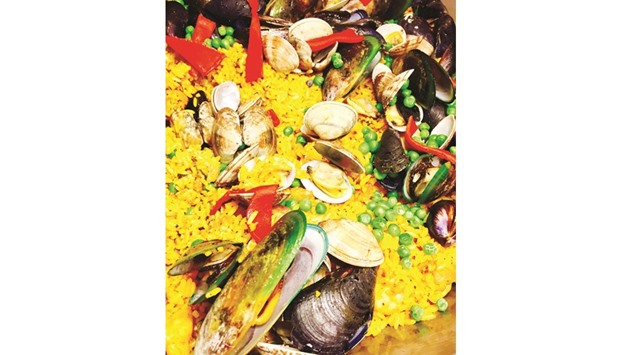Let’s learn about the Spanish paella today. This classic dish originates from Valencia in the eastern Spain.
Dishes change with passing time, as tastes change and cooking methods evolve. Paella has also changed over the course of history into its present form. That’s the reason why many chefs vouch for their recipes to be authentic. This Spanish dish is so popular that you can easily spot this dish in restaurants from America to Europe.
The most popularly accepted story of paella is that the servants in earlier days would collect leftovers from the royal banquets, mix them, and cook over open fires. They would then take the finished products to their families.
The origin of the word “paella” relates to the Arabic word “baqiyah,” which means leftovers. However another speculation is that the world “paella” is derived from the Latin word “patella,” which means a flat plate used for religious offerings.
Two essentials of paella
Paella can be divided into two parts. For a delicious paella, you need to understand and know how to prepare the dish. The first is the body of the paella or the rice, for which short grain rice called Spanish Bomba is used. You can also use Italian risotto or Japanese sushi rice as an alternate.
The second most important essential ingredient is the stock that the rice is cooked in. You need a good quality fish stock by simmering the heads and tails of shellfish for about 30 minutes over slow flame.
One thing that we know for sure is that paella gained popularity in the mid-nineteenth century when paella became a popular dish served to labourers; but the taste of the dish was appreciated so much that people started to treat it as a delicacy, by choosing their shellfish and making it richer and more flavourful.
Today paella as we know is usually cooked over a controlled burner fire in a traditional shallow paella pan. It can be made with rice, chicken, fish, shellfish, eel, rabbit, squid, artichokes, snails, beans, peppers, or any other variety of vegetables you’d like to add. Usually it is seasoned with saffron, amongst other spices. If you order paella outside of Spain, you will probably be served a dish of rice, chicken, and seafood. When cooking paella, it’s best to use a large, flat pan that is open and has handles on either side for easy handling.
You’ll need to make an open fire for authentic taste, and you’ll want to try for an even heat. Controlling the open fore heat is a task in its own. You’ll want to brown the meat while the fire is at its peak, and then let the dish simmer as the fire dies down. You’ll add the seafood last, since it only needs to cook for a short time. Be sure to use medium grain rice, as this soaks up the stock better than long grain rice and buy high quality saffron for best results.
The picture shows a seafood paella that looks stunning, with crustaceans and shellfish. You can vary the quantities of seafood and also use crab, crayfish, or lobster (boil them separately). In olden days, fishermen’s families made seafood paellas without any vegetables due to the abundance of seafood and scarcity of money. When they did not go out to fish, they made arroz de piedras, with mollusks from the rocks. The tradition of mixing meat and seafood is very old – they had pieces of chicken, rabbit, or duck and sausages in their seafood paellas. Today adding meat and vegetables to seafood paella has become common in other regions, where seasonal vegetables such as green beans, peas, artichokes, or peppers also go in. It is called paella mixta.
Mix Meat Paella
Ingredients
Serves 4
Shrimp 21/30 100 gm
Clams 12 nos
Mussels 12 nos
Crabs 4 nos
Olive oil 4 tbsp
Lemon wedge 2 nos
Chicken breast 250 gm
Onion, diced ¼ cup
Garlic, chopped 2 tbsp
Bell peppers, diced ¼ cup
Celery, diced ¼ cup
Green peas ¼ cup
Olives ¼ cup
Parboiled short grain rice 1 cup
Saffron strands 1 gm
Salt to taste
White pepper to taste
Garnish
Parsley 100 gm
Lemon wedge to garnish
Method
Soak rice and keep aside and prepare chicken stock using the bones and vegetable trimmings.
Heat olive oil in a heavy bottom pan over a stove top.
Add diced chicken breast and sauté to a golden brown colour.
Once the chicken is half cooked add diced onion, garlic, bell peppers, green peas, olives and celery and continue to cook over medium flame.
Add the pre-soaked rice, chicken stock, lemon wedge and saffron strands into the mixture and bring to a boil.
Add the washed and cleaned blue crab, shrimp, mussels and clams and adjust the seasoning.
Cover the pan with a lid and simmer over slow flame for about 20-25 minutes.
Once all the water has evaporated, allow to stand for 10 minutes to extract the seafood flavours.
Garnish with freshly chopped parsley leaves and serve hot.
* Chef Tarun Kapoor,
Culinary Mastermind, USA. He may be contacted at [email protected]

Mix Meat Paella. Photo by the author
